Art & Exhibitions
Ai Weiwei, Trevor Paglen, and Taryn Simon Install Works in Fukushima’s Radioactive Zone
You can’t see the show, but that’s part of the concept.
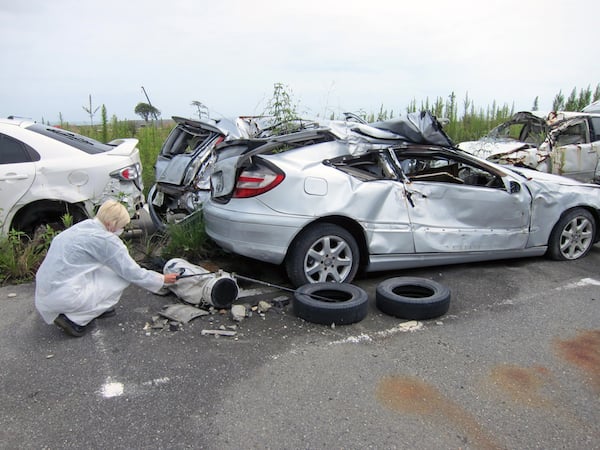
Photo: Courtesy “Don’t Follow the Wind”
You can’t see the show, but that’s part of the concept.

Lorena Muñoz-Alonso

A disturbing photograph of a cluster of mutant daisies found 110 kilometers from Fukushima, Japan, that has gone viral in the last few days, also coincided with the news of an art exhibition currently taking place in the Exclusion Zone of the nuclear disaster site.
In March 2011, a 9.0 magnitude earthquake—the most powerful to have hit Japan in recorded history—provoked a tsunami that, as well as claiming 20,000 lives, caused a devastating nuclear disaster in the Fukushima Daiichi Nuclear Power Plant. Radioactive material leaked into the water, forcing the evacuation of 300,000 people.
Four years later, a group of artists and curators have traveled to the area to install the exhibition “Don’t Follow the Wind,” spearheaded by the collective Chim↑Pom, who famously traveled to Fukushima shortly after the disaster, engaged with the community there, and planted a Japanese flag with a radioactive symbol.
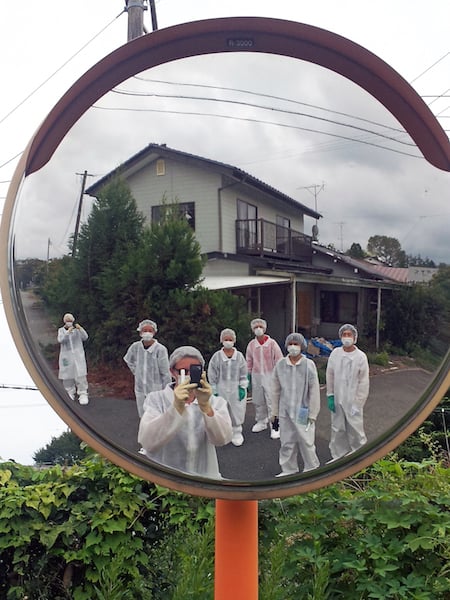
The curatorial team visiting one of the three exhibition venues in Fukushima.
Photo: Courtesy of “Don’t Follow the Wind.”
The curators of the exhibition—Kenji Kubota, Jason Waite, and the artist duo Eva and Franco Mattes—have invited 12 artists, including Ai Weiwei, Grand Guignol Mirai, Nikolaus Hirsch and Jorge Otero-Pailos, Takeuchi Kota, Takekawa Nobuaki, Ahmet Ögüt, Trevor Paglen, and Taryn Simon, to create new works for the show over the course of a year.
The resulting site-specific artworks are being installed in four contaminated sites lent by former residents—a home, a warehouse, a farm, and a recreation center—all of which were evacuated immediately after the disaster.
But the twist of this very particular show is that, due to obvious health and safety reasons, no one will be able see the works in the next few decades—that is, until the area is safe again. The exhibition, as the press release puts it, “will be ongoing but largely invisible—a condition akin to radiation itself—only to be viewed in the future.”
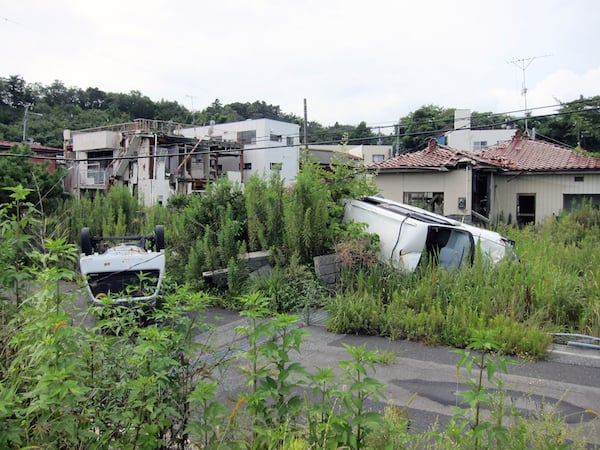
View of the Fukushima Exclusion Zone.
Photo: Courtesy of “Don’t Follow the Wind.”
Invisibility thus seems central to the project. “Radiation, like the building up of CO2 in the atmosphere, highlights that the causes of the most urgent threats to our collective existence—nuclear catastrophe and climatic shifts—cannot be seen, only becoming apparent in their disastrous effect,” the show’s co-curator Waite told artnet News.
“We don’t want to avoid the invisibility but embrace its alternative potential, as an invitation to use other senses and induce a speculation that can expand to imagine new ways of living together.”
This conceptual curatorial device is certainly poetic, as one’s imagination does wander off trying to visualize these ghostly artworks in their dystopian, Andrei Tarkovsky-esque settings. To obscure things even further, not even documentation or photographs of the works and sites will be made available, “in an act of solidarity with the residents until they can return to their homes.”
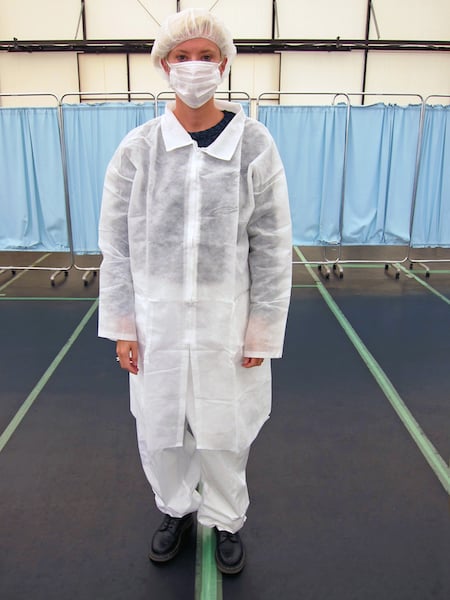
Artist Eva Mattes getting ready to enter the Zone.
Photo: Courtesy of “Don’t Follow the Wind.”
Radiation, however, is a very real danger, which the curators and artists faced when entering the Zone. How did it feel to be there?
“We all wore coverall suits, gloves, and masks,” Eva Mattes told artnet News. “They only protect you from radioactive dust though. Radiation goes through your body. You cannot see, smell, taste or hear it. The constant beeping of the Geiger counters follows you everywhere, it’s a reminder that every second you spend there you are being irradiated. Sometimes all the counters’ alarms set off at the same time, because you’re going through an area that is particularly ‘hot,’ or you stepped too close to something very radioactive.”
“The four exhibition venues were generously lent to us by former residents,” Mattes added. “In a sense, the sites are the polar opposite of a typical ‘white cube,’ which is aseptic and anonymous. These are contaminated and filled with personal belongings—abandoned furniture, clothes, photographs and books—infused of the owners’ personal memories. It is a very delicate process.”
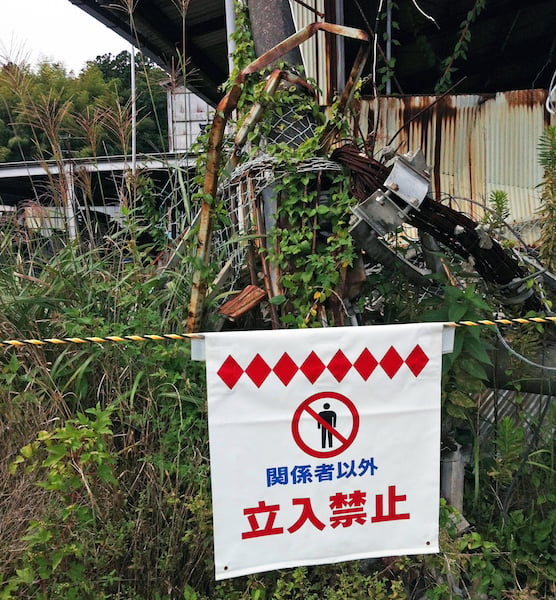
View of the Fukushima Exclusion Zone.
Photo: Courtesy of “Don’t Follow the Wind.”
Because of the lack of concrete information about it (intangibility being one of its main assets), “Don’t Follow the Wind” has managed to elicit a number of skeptical reactions in the press, a scathing write-up in the Guardian by Jonathan Jones in particular.
In his article, entitled Apocalypse no! Why artists should not go into the Fukushima exclusion zone, Jones calls the project “fatuous,” a “stunt,” and a “gesture,” and the Fukushima disaster “an example of a well-managed and successfully contained nuclear accident.”
However, with many voices calling the tragedy the world’s worst nuclear accident since Chernobyl and Japan’s greatest crisis since World War II, it seems that an exhibition like “Don’t Follow the Wind”—which serves to remind us that the consequences of the catastrophe are still unfolding for many, and which puts the daily lives of those affected by the tragedy at center stage—is very much necessary today.
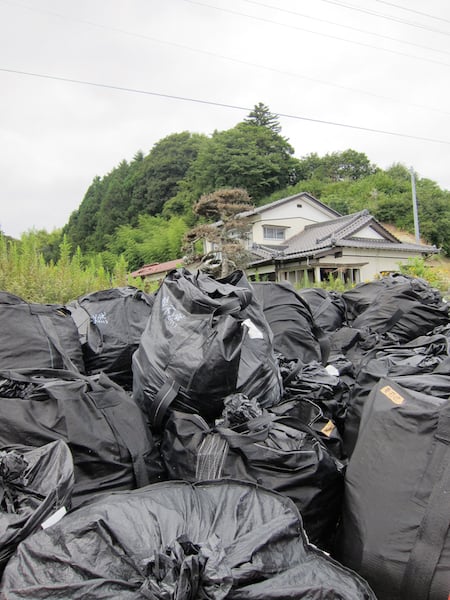
Bags of nuclear waste in the Fukushima Exclusion Zone.
Photo: Courtesy of “Don’t Follow the Wind.”